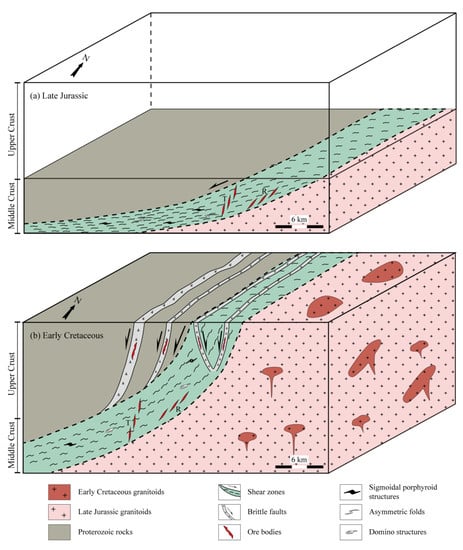New Insight into the Genetic Mechanism of Shear Zone Type Gold Deposits from Muping-Rushan Metallogenic Belt (Jiaodong Peninsula of Eastern China)
Abstract
:1. Introduction
2. Geological Setting
3. New Structural Insights
3.1. Ductile Deformation of the MR
3.2. Brittle Deformation of the MR
4. Microscopic Observations and Deformation Conditions
4.1. Microscopic Observations in the MR
4.2. EBSD Analysis
4.3. Fractal Analysis of Dynamically Recrystallized Quartz Grains
5. Deposit Geology
6. Discussion
6.1. Geological Characteristics of the MR
6.2. Relationship Between the MR and Gold Mineralization
6.3. Implication to the Genetic Mechanism of the Shear Zone Type Gold Deposits
6.3.1. Comparison to other Gold Deposits
6.3.2. Genetic Mechanism for SZTGD
7. Conclusions
Author Contributions
Funding
Acknowledgments
Conflicts of Interest
References
- Fossen, H. Structural Geology, 2nd ed.; Cambridge University Press: New York, NY, USA, 2016; pp. 25–254. [Google Scholar]
- Deng, J.; Zhai, Y.S.; Yang, L.Q.; Fang, Y.; Yan, W.D. On ore-forming system of shear zone tectonics. Geoscience 1998, 12, 493–500. [Google Scholar]
- Liu, J.L. Strain localization and strain weakening in the continental middle crust. Acta Petrol. Sin. 2017, 33, 1653–1666. [Google Scholar]
- Robert, F.; Kelly, W.C. Ore-forming fluids in Archean gold-bearing quartz veins at the Sigma Mine, Abitibi greenstone belt, Quebec, Canada. Econ. Geol. 1987, 82, 1464–1482. [Google Scholar] [CrossRef]
- Song, C.; Wei, W.; Hou, Q.L.; Liu, Q.; Zhang, H.Y.; Wu, S.C.; Zhu, H.F.; Li, H. Geological characteristics of the Laoshan’ao shear zone and its relationship with the Xiangdong tungsten deposit, Chaling, eastern Hunan Province. Acta Petrol. Sin. 2016, 32, 1571–1580. [Google Scholar]
- Spencer, J.E.; Welty, J.W. Possible controls of base-and precious-metal mineralization associated with Tertiary detachment faults in the Lower Colorado River Trough, Arizona and California. Geology 1986, 14, 195. [Google Scholar] [CrossRef]
- Wei, W.; Song, C.; Hou, Q.L.; Chen, Y.; Faure, M.; Yan, Q.R.; Liu, Q.; Sun, J.F.; Zhu, H.F. The Late Jurassic extensional event in the central part of the South China Block–evidence from the Laoshan’ao shear zone and Xiangdong Tungsten deposit (Hunan, SE China). Int. Geol. Rev. 2018, 60, 1644–1664. [Google Scholar] [CrossRef]
- Dirks, P.H.G.M.; Charlesworth, E.G.; Munyai, M.R.; Wormald, R. Stress analysis, post-orogenic extension and 3.01 Ga gold mineralisation in the Barberton Greenstone Belt, South Africa. Precambrian Res. 2013, 226, 157–184. [Google Scholar] [CrossRef]
- Groves, D.I. The crustal continuum model for late-Archaean lode-gold deposits of the Yilgarn Block, Western Australia. Miner. Depos. 1993, 28, 366–374. [Google Scholar] [CrossRef]
- Groves, D.I.; Goldfarb, R.J.; Gebre-Mariam, M.; Hagemann, S.G.; Robert, F. Orogenic gold deposits: A proposed classification in the context of their crustal distribution and relationship to other gold deposit types. Ore Geol. Rev. 1998, 13, 7–27. [Google Scholar] [CrossRef]
- Olivo, G.R.; Chang, F.; Kyser, T.K. Formation of the auriferous and barren North Dipper Veins in the Sigma Mine, Val d’Or, Canada: Constraints from structural, mineralogical, fluid Inclusion, and isotopic data. Econ. Geol. 2006, 101, 607–631. [Google Scholar] [CrossRef]
- Olivo, G.R.; Williams-Jones, A.E. Genesis of the auriferous C quartz-tourmaline vein of the Siscoe mine, Val d’Or district, Abitibi subprovince, Canada: Structural, mineralogical and fluid inclusion constraints. Econ. Geol. 2002, 97, 929–947. [Google Scholar] [CrossRef]
- Rezeau, H.; Moritz, R.; Beaudoin, G. Formation of Archean batholith-hosted gold veins at the Lac Herbin deposit, Val-d’Or district, Canada: Mineralogical and fluid inclusion constraints. Miner. Depos. 2017, 52, 421–442. [Google Scholar] [CrossRef]
- Sanislav, I.V.; Brayshaw, M.; Kolling, S.L.; Dirks, P.H.G.M.; Cook, Y.A.; Blenkinsop, T.G. The structural history and mineralization controls of the world-class Geita Hill gold deposit, Geita Greenstone Belt, Tanzania. Miner. Depos. 2017, 52, 257–279. [Google Scholar] [CrossRef] [Green Version]
- Yang, L.Q.; Deng, J.; Wang, Z.L.; Zhang, L.; Guo, L.N.; Song, M.C.; Zheng, X.L. Mesozoic and metallogenic system of the Jiaodong gold province, eastern China. Acta Petrol. Sin. 2014, 30, 2447–2467. [Google Scholar]
- Chen, B.L.; Dong, F.X.; Li, Z.J. Ore-forming model of ductile shear zone type gold deposits. Geol. Rev. 1999, 45, 186–192. [Google Scholar]
- Wang, Y.T.; Mao, J.W.; Li, X.F.; Yang, F.Q. Gold mineralization related to the shear zone. Earth Sci. Front. 2004, 11, 393–400. [Google Scholar]
- Boullier, A.M.; Robert, F. Palaeoseismic events recorded in Archaean gold-quartz vein networks, Val d’Or, Abitibi, Quebec, Canada. J. Struct. Geol. 1992, 14, 161–179. [Google Scholar] [CrossRef]
- Cheng, N.N.; Liu, Q.; Hou, Q.L.; Wei, W.; Shi, M.Y.; He, M.; Guo, Q.Q. Discussions on the stress-chemical process of gold precipitation and metallogenic mechanism in shear zone type gold deposits. Acta Petrol. Sin. 2018, 34, 2165–2180. [Google Scholar]
- Nguyen, P.T.; Harris, L.B.; Powell, C.M.; Cox, S.F. Fault-valve behaviour in optimally oriented shear zones: An example at the Revenge gold mine, Kambalda, Western Australia. J. Struct. Geol. 1998, 20, 1625–1640. [Google Scholar] [CrossRef]
- Groves, D.I.; Phillips, G.N.; Ho, S.E.; Houstoun, S.M.; Standing, C.A. Craton-scale distribution of greenstone gold deposits: Predictive capacity of the metamorphic model. Econ. Geol. 1988, 83, 2045–2058. [Google Scholar] [CrossRef]
- Hodgson, C.J. The structure of shear-related, vein-type gold deposits: A review. Ore Geol. Rev. 1989, 4, 231–273. [Google Scholar] [CrossRef]
- Lister, G.S.; Snoke, A.W. S-C mylonites. J. Struct. Geol. 1984, 6, 617–638. [Google Scholar] [CrossRef]
- Sibson, R.H.; Robert, F.; Poulsen, K.H. High-angle reverse faults, fluid-pressure cycling, and mesothermal gold-quartz deposits. Geology 1988, 16, 551–555. [Google Scholar] [CrossRef]
- Song, M.C.; Yi, P.H.; Xu, J.X.; Cui, S.X.; Shen, K.; Jiang, H.L.; Yuan, W.H.; Wang, H.J. A step metallogenetic model for gold deposits in the northwestern Shandong Peninsula, China. Sci. China Earth Sci. 2012, 42, 992–1000. [Google Scholar] [CrossRef]
- Fan, H.R.; Hu, F.F.; Yang, J.H.; Shen, K.; Zhai, M.G. Fluid evolution and large scale gold metallogeny during Mesozoic tectonic transition in the eastern Shandong Province. Acta Petrol. Sin. 2005, 21, 1317–1328. [Google Scholar]
- Deng, J.; Wang, Q.F. Gold mineralization in China: Metallogenic provinces, deposit types and tectonic framework. Gondwana Res. 2016, 36, 219–274. [Google Scholar] [CrossRef]
- Song, M.C.; Li, S.Z.; Santosh, M.; Zhao, S.; Yu, S.; Yi, P.H.; Cui, S.X.; Lv, G.X.; Xu, J.X.; Song, Y.X. Types, characteristics and metallogenesis of gold deposits in the Jiaodong Peninsula, Eastern North China Craton. Ore Geol. Rev. 2015, 65, 612–625. [Google Scholar] [CrossRef]
- Zhu, R.X.; Fan, H.R.; Li, J.W.; Meng, Q.R.; Li, S.R.; Zeng, Q.D. Decratonic gold deposits. Sci. China Earth Sci. 2015, 58, 1523–1537. [Google Scholar] [CrossRef]
- Lü, G.X.; Li, H.K.; Ding, Z.J.; Han, F.F.; Li, B.H. Hydrothermal alteration metallogenesis in the determination zone of a "magmatic core complex" upheaval-detachment structure, Jiaodong. Geoscience 2016, 30, 247–262. [Google Scholar]
- Wen, B.J.; Fan, H.R.; Santosh, M.; Hu, F.F.; Pirajno, F.; Yang, K.F. Genesis of two different types of gold mineralization in the Linglong gold field, China: Constrains from geology, fluid inclusions and stable isotope. Ore Geol. Rev. 2015, 65, 643–658. [Google Scholar] [CrossRef]
- Tan, J.; Wei, J.H.; Guo, L.L.; Zhang, K.Q.; Yao, C.L.; Lu, J.P.; Li, H.M. LA-ICP-MS zircon U-Pb dating and phenocryst EPMA of dikes, Guocheng, Jiaodong Peninsula: Implications for North China Craton lithosphere evolution. Sci. China Earth Sci. 2008, 51, 1483–1500. [Google Scholar] [CrossRef]
- Yang, Z.F.; Xu, J.K.; Zhao, L.S. Regional Crust Evolution and Geochemistry of Gold Mineralization in Jiaodong Peninsula; Geological Publishing House: Beijing, China, 1998; pp. 1–157. [Google Scholar]
- Li, J.W.; Paulo, V.; Zhou, M.F.; Fu, Z.X.; Qian, M.C. Geochronology of the Pengjiakuang and Rushan gold deposits, eastern Jiaodong gold province, northeastern China: Implications for regional mineralization and geodynamic setting. Econ. Geol. 2006, 101, 1023–1038. [Google Scholar]
- Qiu, J.S.; Wang, D.Z.; Luo, Q.H.; Liu, H. 40Ar/39Ar dating for volcanic rocks of Qingshan formation in Jiaolai Basin, Eastern Shandong province: A Case study of the Fenlingshan volcanic apparatus in Wulian county. Geo. J. China Univ. 2001, 7, 351–355. [Google Scholar]
- Goss, S.C.; Wilde, S.A.; Wu, F.Y.; Yang, J.H. The age, isotopic signature and significance of the youngest Mesozoic granitoids in the Jiaodong Terrane, Shandong Province, North China Craton. Lithos 2010, 120, 309–326. [Google Scholar] [CrossRef]
- Guo, J.H.; Chen, F.K.; Zhang, X.M.; Siebel, W.; Zhai, M.G. Evolution of syn- to post-collisional magmatism from north Sulu UHP belt, eastern China: Zircon U-Pb geochronology. Acta Petrol. Sin. 2005, 21, 1281–1301. [Google Scholar]
- Hu, F.F.; Fan, H.; Yang, K.F.; Shen, K.; Zhai, M.G.; Jin, C.W. Fluid inclusions in the Denggezhuang lode gold deposit at Muping, Jiaodong Peninsula. Acta Petrol. Sin. 2007, 23, 2155–2164. [Google Scholar]
- Li, H.K.; Li, D.P.; Geng, K.; Guo, B.K.; Zhuo, C.Y.; Liang, T.T. The Mesozoic magmaticactivities framwork in Jiaodong Area: SHRIMP chronology recording of single particle zircon. Acta Geol. Sin. 2017, 91, 163–179. [Google Scholar] [CrossRef] [Green Version]
- Yu, X.F.; Li, H.K.; Shan, W. Study on coupling between Yanshannian tectonic thermal events and gold mineralization in Jiaodong ore concentrating area in Shandong Province. Acta Geol. Sin. 2012, 86, 1946–1956. [Google Scholar]
- Lin, B.L.; Li, B.L. Geochemistry, U-Pb dating Lu-Hf isotopic analysis and gological significance of Linglong granite in Jiaodong Peninsula. J. Chengdu Univ. Technol. (Sci. Technol. Ed.) 2013, 40, 147–160. [Google Scholar]
- Wang, Z.L.; Zhao, R.X.; Zhang, Q.; Lu, H.W.; Li, J.L.; Cheng, W. Magma mixing for the high Ba-Sr Guojialing-type granitoids in Northest Jiaodong Peninsula: Constraints from petrogeochemistry and Sr-Nd isotopes. Acta Petrol. Sin. 2014, 30, 2595–2608. [Google Scholar]
- Yang, Q.Y.; Santosh, M.; Shen, J.F.; Li, S.R. Juvenile vs. recycled crust in NE China: Zircon U–Pb geochronology, Hf isotope and an integrated model for Mesozoic gold mineralization in the Jiaodong Peninsula. Gondwana Res. 2014, 25, 1445–1468. [Google Scholar] [CrossRef]
- Liu, S.; Hu, R.; Gao, S.; Feng, C.; Yu, B.; Feng, G.; Qi, Y.; Wang, T.; Coulson, I.M. Petrogenesis of Late Mesozoic mafic dykes in the Jiaodong Peninsula, eastern North China Craton and implications for the foundering of lower crust. Lithos 2009, 113, 621–639. [Google Scholar] [CrossRef]
- Ma, L.; Jiang, S.Y.; Hofmann, A.W.; Dai, B.Z.; Hou, M.L.; Zhao, K.D.; Chen, L.H.; Li, J.W.; Jiang, Y.H. Lithospheric and asthenospheric sources of lamprophyres in the Jiaodong Peninsula: A consequence of rapid lithospheric thinning beneath the North China Craton? Geochim. Cosmochim. Acta 2014, 124, 250–271. [Google Scholar] [CrossRef]
- Yang, J.H.; Zhu, M.F.; Liu, W.; Zhai, M.G. Geochemistry and petrogenesis of Guojialing granodiorites from the northwestern Jiaodong Peninsula, eastern China. Acta Petrol. Sin. 2003, 19, 692–700. [Google Scholar]
- Li, X.C. Hydrothermal Alteration Associated with Mesozoic Granite-Hosted Gold Mineralization at the Sanshandao Deposit, Jiaodong Gold Province, China. Master’s Thesis, Institute of Geology and Geophysics, Chinese Acedemy of Sciences, Beijing, China, 2012. [Google Scholar]
- Goldfarb, R.J.; Groves, D.I.; Gardoll, S. Orogenic gold and geologic time: A global synthesis. Ore Geol. Rev. 2001, 18, 1–75. [Google Scholar] [CrossRef]
- Zhu, G.; Chen, Y.; Jiang, D.Z.; Lin, S.Z. Rapid change from compression to extension in the North China Craton during the Early Cretaceous: Evidence from the Yunmengshan metamorphic core complex. Tectonophysics 2015, 656, 91–110. [Google Scholar] [CrossRef]
- Fan, H.R.; Zhai, M.G.; Xie, Y.H.; Yang, J.H. Ore-forming fluids associated with granite-hosted gold mineralization at the Sanshandao deposit, Jiaodong gold province, China. Miner. Depos. 2003, 38, 739–750. [Google Scholar] [CrossRef]
- Xue, J.L.; Pang, Z.S.; Li, S.R.; Chen, H.; Sun, H.Y.; Tao, W.; Yao, L.; Zhang, Y.Q. The genesis of Denggezhuang gold deposit in Jiaodong: Constraints from multigeological chronology and isotope system. Acta Petrol. Sin. 2019, 35, 1532–1550. [Google Scholar]
- Li, X.F.; Liu, J.C.; Zhang, X.R.; Yu, H. Structural features and metallogenic prognosis of Muping-Rushan gold ore belt. Gold Sci. Technol. 2013, 21, 10–15. [Google Scholar]
- Hu, F.F. Magmatism, Ore Fluid Evolution and Gold Mineralization of the Kunyushan Area in the Jiaodong Peninsula during the Mesozoic Tectonic Regime Inversion in Eastern China. Ph.D. Thesis, Institute of Geology and Geophysics, Chinese Acedemy of Sciences, Beijing, China, 2006. [Google Scholar]
- Hu, F.F.; Fan, H.R.; Yang, J.H.; Wang, F.; Zhai, M.G. The 40Ar/39Ar dating age of sericite from altered rocks in the Rushan lode gold deposit, Jiaodong Peninsula and its constraints on the gold mineralization. Bull. Miner. Petrol. Geochem. 2006, 25, 109–114. [Google Scholar]
- Hu, F.F.; Fan, H.R.; Yang, J.H.; Wan, Y.S.; Liu, D.Y.; Zhai, M.G.; Jin, C.W. The mineralization age in the Rushan lode gold deposit: Determination by SHRIMP U-Pb dating for hydrothermal zircon. Sci. Bull. 2004, 49, 1191–1198. [Google Scholar] [CrossRef]
- Xue, J.L. Mineralization and Metallogenic Prognosis of Gold Deposits in Muping-Rushan Gold Belt, Jiaodong Peninsula. Ph.D. Thesis, China University of Geosciences, Beijing, China, 2013. [Google Scholar]
- Li, X.F.; Liu, J.C.; Yu, H.; Gao, P.; Zhang, X.; Cheng, H. The geological characteristics and prospecting criteria of Yinggezhuang gold deposit, Jiaodong. Gold Sci. Technol. 2010, 18, 99–112. [Google Scholar]
- Zhu, G.; Niu, M.; Xie, C.; Wang, Y. Sinistral to Normal Faulting along the Tan-Lu Fault Zone: Evidence for Geodynamic Switching of the East China Continental Margin. J. Geol. 2010, 118, 277–293. [Google Scholar] [CrossRef]
- Angelier, J. Determination of the mean principal directions of stresses for a given fault population. Tectonophysics 1979, 56, T17–T26. [Google Scholar] [CrossRef]
- Angelier, J. Tectonic analysis of fault slip data sets. J. Geophys. Res. Solid Earth 1984, 89, 5835–5848. [Google Scholar] [CrossRef]
- Sasvári, Á.; Baharev, A. SG2PS (structural geology to postscript converter): A graphical solution for brittle structural data evaluation and paleostress calculation. Comput. Geosci. 2014, 66, 81–93. [Google Scholar]
- Angelier, J. Fault Slip Analysis and Paleostress Reconstruction; Pergamon Press: New York, NY, USA, 1994; pp. 53–100. [Google Scholar]
- Passchier, C.W.; Trouw, R.A.J. Microtectonics; Springer: Berlin/Heidelberg, Germany, 2005; pp. 1–366. [Google Scholar]
- Wu, W.B.; Liu, J.L.; Zhang, L.S.; Qi, Y.C.; Ling, C.Y. Characterizing a middle to upper crustal shear zone: Microstructures, quartz c-axis fabrics, deformation temperatures and flow vorticity analysis of the northern Ailao Shan-Red River shear zone. J. Asian Earth Sci. 2016, 139, 95–114. [Google Scholar] [CrossRef]
- Huang, X.M.; Zhang, J.J.; Xu, Z.Q. The application of EBSD in the study of crustal structural deformation. Acta Geol. Sin. 2016, 90, 1130–1145. [Google Scholar]
- Liu, J.L.; Cao, S.Y.; Zou, Y.X.; Song, Z.J. EBSD analysis of rock fabrics and its application. Geol. Bull. China 2008, 27, 1638–1645. [Google Scholar]
- Xia, Z.M.; Liu, J.L.; Jinlong, N.I.; Zhang, T.T.; Shi, X.M.; Yun, W.U. Structure, evolution and regional tectonic implications of the Queshan metamorphic core complex in eastern Jiaodong Peninsula of China. Sci. China Earth Sci. 2016, 59, 997–1013. [Google Scholar] [CrossRef]
- Halfpenny, A.; Prior, D.J.; Wheeler, J. Electron backscatter diffraction analysis to determine the mechanisms that operated during dynamic recrystallisation of quartz-rich rocks. J. Struct. Geol. 2012, 36, 2–15. [Google Scholar] [CrossRef]
- White, S. Geological significance of recovery and recrystallization processes in quartz. Tectonophysice 1977, 39, 143–170. [Google Scholar] [CrossRef]
- Heilbronner, R.; Tullis, J. Evolution of c axis pole figures and grain size during dynamic recrystallization: Results from experimentally sheared quartzite. J. Geophys. Res. Solid Earth 2006, 111, 1–19. [Google Scholar] [CrossRef]
- Xia, H.R.; Liu, J.L. The crystallographic preferred orientation of quartz and its applications. Geol. Bull. China 2011, 30, 58–70. [Google Scholar]
- Zheng, Y.D.; Wang, T.; Zhang, J.J. Theory and practice of kinematic vorticity (Wk). Earth Sci. Front. 2008, 15, 209–220. [Google Scholar]
- Kruhl, J.H.; Nega, M. The fractal shape of sutured quartz grain boundaries: Application as a geothermometer. Geol. Rundsch. 1996, 85, 38–43. [Google Scholar] [CrossRef]
- Kruhl, J.H.; Nega, M.; Milla, H.E. The Fractal Shape of Grain Boundary Sutures: Reality, Model and Application as a Geothermometer. 1995; pp. 31–32. Available online: https://www.researchgate.net/publication/312450687_The_fractal_shape_of_grain_boundary_sutures_Reality_model_and_application_as_a_geothermometer (accessed on 12 December 2019).
- Takahashi, M.; Nagahama, H.; Masuda, T.; Fujimura, A.; Rutter, E.H.; Boriani, A.; Brodie, K.H.; Burlini, L.; Treagus, S.H. Fractal analysis of experimentally, dynamically recrystallized quartz grains and its possible application as a strain rate meter. J. Struct. Geol. 1998, 20, 269–275. [Google Scholar] [CrossRef]
- Li, J.; Liu, Y.J.; Li, W.M.; Jin, W.; Liang, C.Y.; Wen, Q.B.; Zhang, Y.Y. Structural deformation and rheology of granitic gneiss from the North China Craton Basement-An example from the Sierbao area in western Liaoning Province. Geotecton. Metallog. 2016, 40, 891–907. [Google Scholar]
- Liang, C.Y.; Liu, Y.J.; Meng, J.Y.; Wen, Q.B.; Li, W.M.; Zhao, Y.L.; Mi, X.N.; Zhang, L. Strain and fractal analysis of dynamically recrystallized quartz grains and rehological parameter estimation of Shulan ductile shear zone. Earth Sci. J. China Univ. Geosci. 2015, 40, 115–129. [Google Scholar]
- Zhang, B.; Zhang, J.J.; Guo, L. Fractal analysis of dynamically recrystallized quartz grains and estimation of mainly rheological parameters of the Ranba ductile shear zone, northern Himalaya dome belt. Chin. J. Geol. 2006, 41, 158–169. [Google Scholar]
- Liu, J.L.; Davis, G.A.; Ji, M.; Guan, H.M.; Bai, X.D. Crustal detachment and destruction of the North China craton: Constraints from Late Mesozoic extensional structures. Earth Sci. Front. 2008, 15, 72–81. [Google Scholar] [CrossRef]
- Charles, N.; Gumiaux, C.; Augier, R.; Chen, Y.; Zhu, R.X.; Lin, W. Metamorphic core complexes vs. synkinematic plutons in continental extension setting: Insights from key structures (Shandong Province, eastern China). J. Asian Earth Sci. 2011, 40, 261–278. [Google Scholar] [CrossRef] [Green Version]
- Ni, J.L.; Liu, J.L.; Tang, X.L.; Yang, H.B.; Xia, Z.M.; Guo, Q.J. The Wulian metamorphic core complex: A newly discovered metamorphic core complex along the Sulu orogenic belt, eastern China. J. Earth Sci. 2013, 24, 297–313. [Google Scholar] [CrossRef]
- Yang, X.A.; Zhao, G.C.; Song, Y.B.; Tian, F.; Dong, H.W.; Gao, J.W. Characteristics of ore-controlling detachment fault and future prospecting in the Muping-Rushan metallogenic belt, eastern Shandong Province. Geotecton. Metallog. 2011, 35, 339–347. [Google Scholar]
- Lin, S.Z.; Zhu, G.; Yan, L.J.; Jiang, Q.Q.; Zhao, T. Discussion on uplifting mechanism of the Linglong Batholith in eastern Shandong. Geol. Rev. 2013, 59, 832–844. [Google Scholar]
- Kolb, J. The role of fluids in partitioning brittle deformation and ductile creep in auriferous shear zones between 500 and 700 °C. Tectonophysics 2008, 446, 1–15. [Google Scholar] [CrossRef]
- Phillips, W.J. Hydraulic fracturing and mineralization. J. Geol. Soc. 1972, 128, 337–359. [Google Scholar] [CrossRef]
- Weatherley, D.K.; Henley, R.W. Flash vaporization during earthquakes evidenced by gold deposits. Nat. Geosci. 2013, 6, 294–298. [Google Scholar] [CrossRef]
- Goldfarb, R.J.; Groves, D.I. Orogenic gold: Common or evolving fluid and metal sources through time. Lithos 2015, 233, 2–26. [Google Scholar] [CrossRef]
- Groves, D.I.; Santosh, M. The giant Jiaodong gold province: The key to a unified model for orogenic gold deposits? Geol. Front. 2016, 7, 409–417. [Google Scholar] [CrossRef] [Green Version]
- Wu, F.Y.; Wang, J.G.; Liu, C.Z.; Liu, T.; Zhang, C.; Ji, W.Q. Intra-oceanic arc: Its formation and evolution. Acta Petrol. Sin. 2019, 35, 1–15. [Google Scholar]
- Cai, Y.C.; Fan, H.R.; Santosh, M.; Hu, F.F.; Yang, K.F.; Li, X.H. Decratonic gold mineralization: Evidence from the Shangzhuang gold deposit, eastern North China Craton. Gondwana Res. 2018, 54, 1–22. [Google Scholar] [CrossRef]
- Benning, L.G.; Seward, T.M. Hydrosulphide complexing of Au (I) in hydrothermal solutions from 150–400 °C and 500–1500 bar. Geochim. Cosmochim. Acta 1996, 60, 1849–1871. [Google Scholar] [CrossRef]
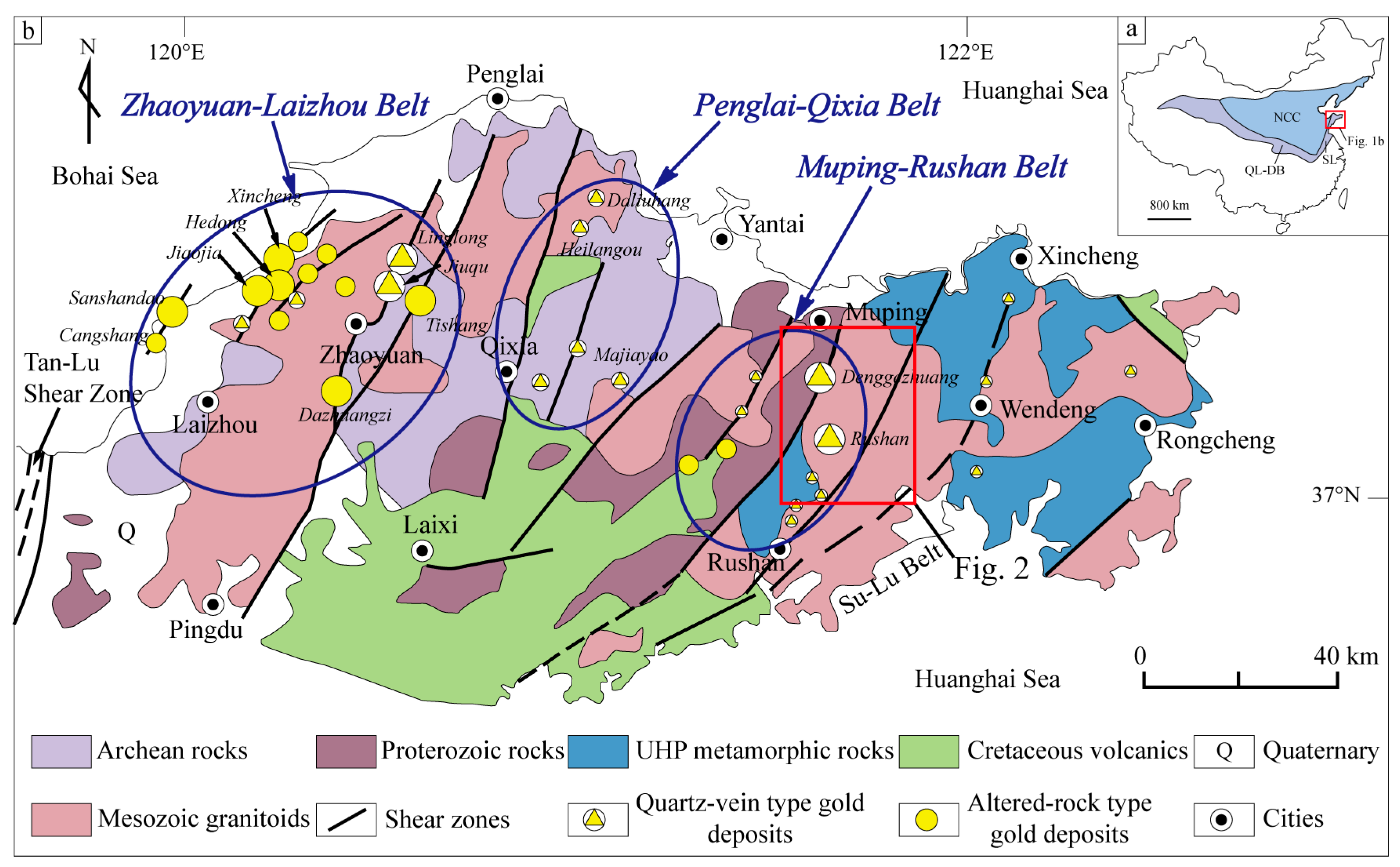
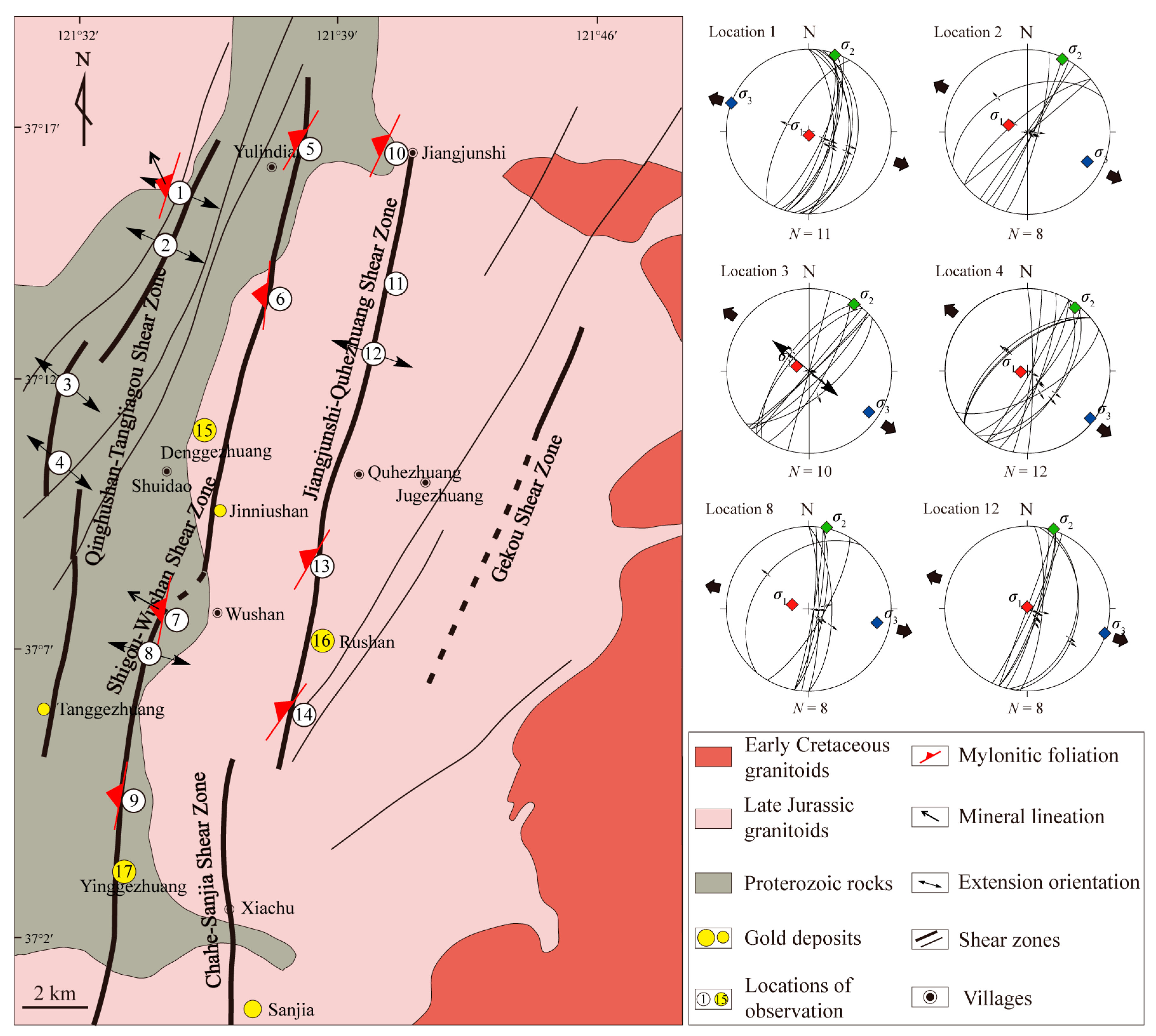


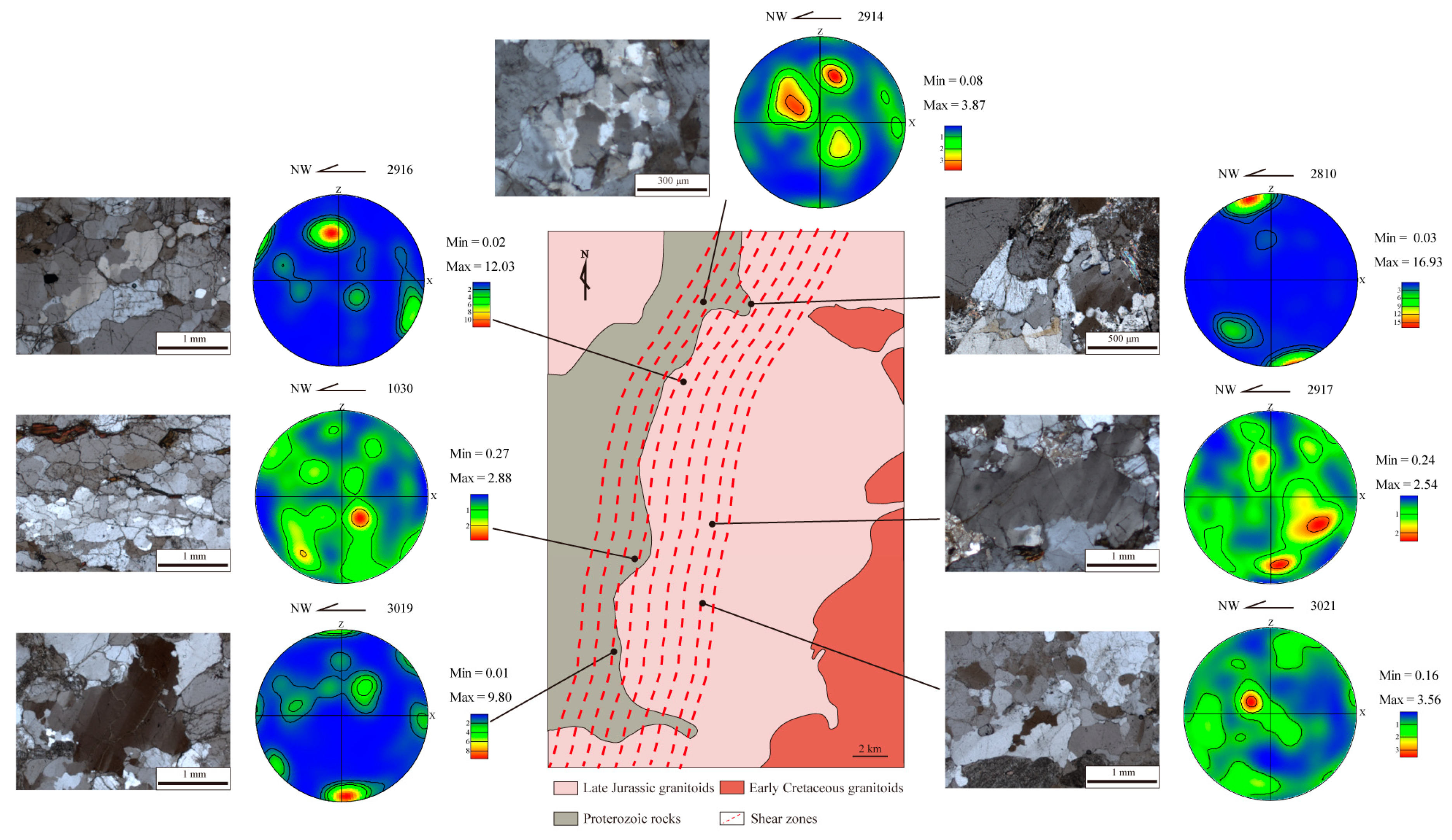
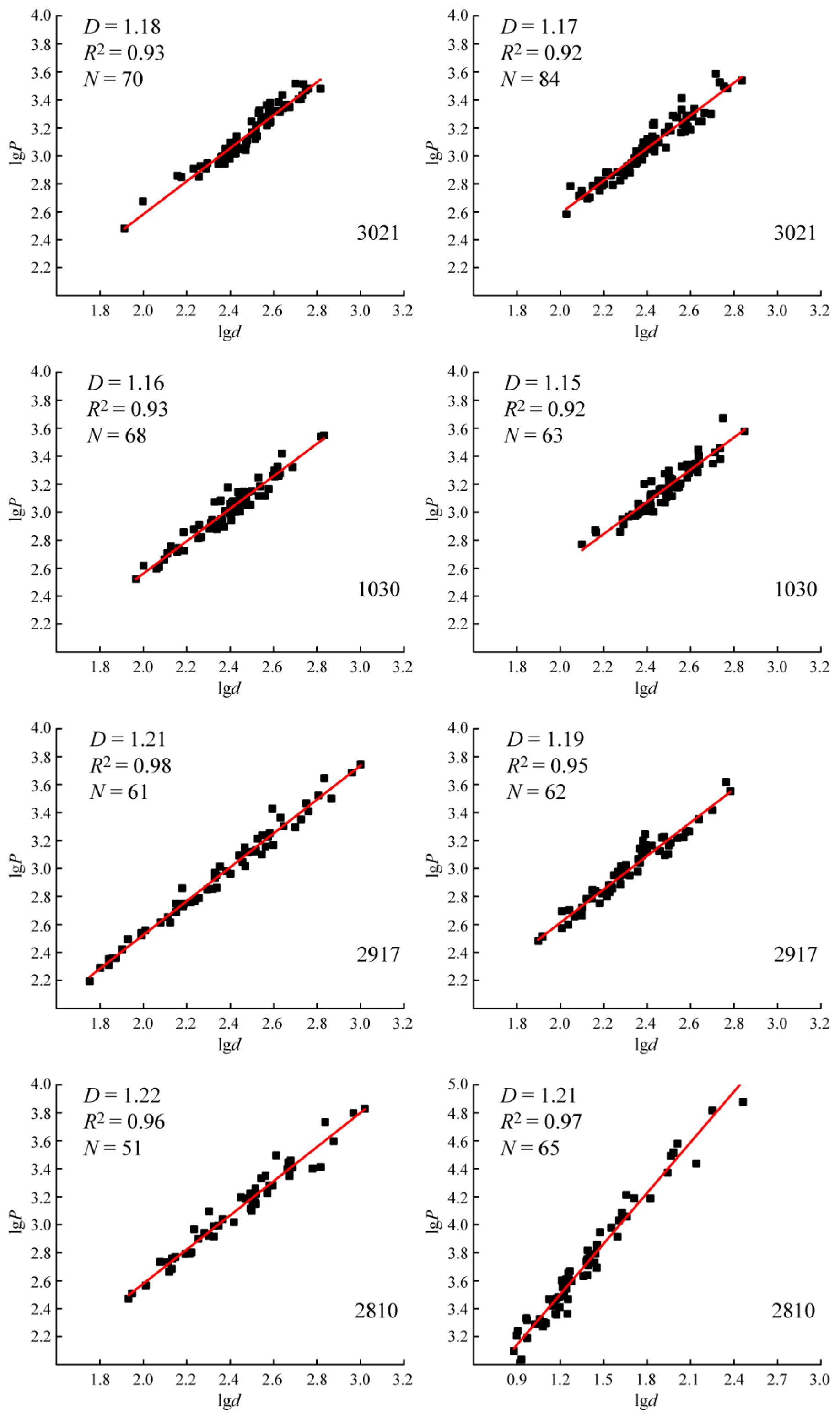



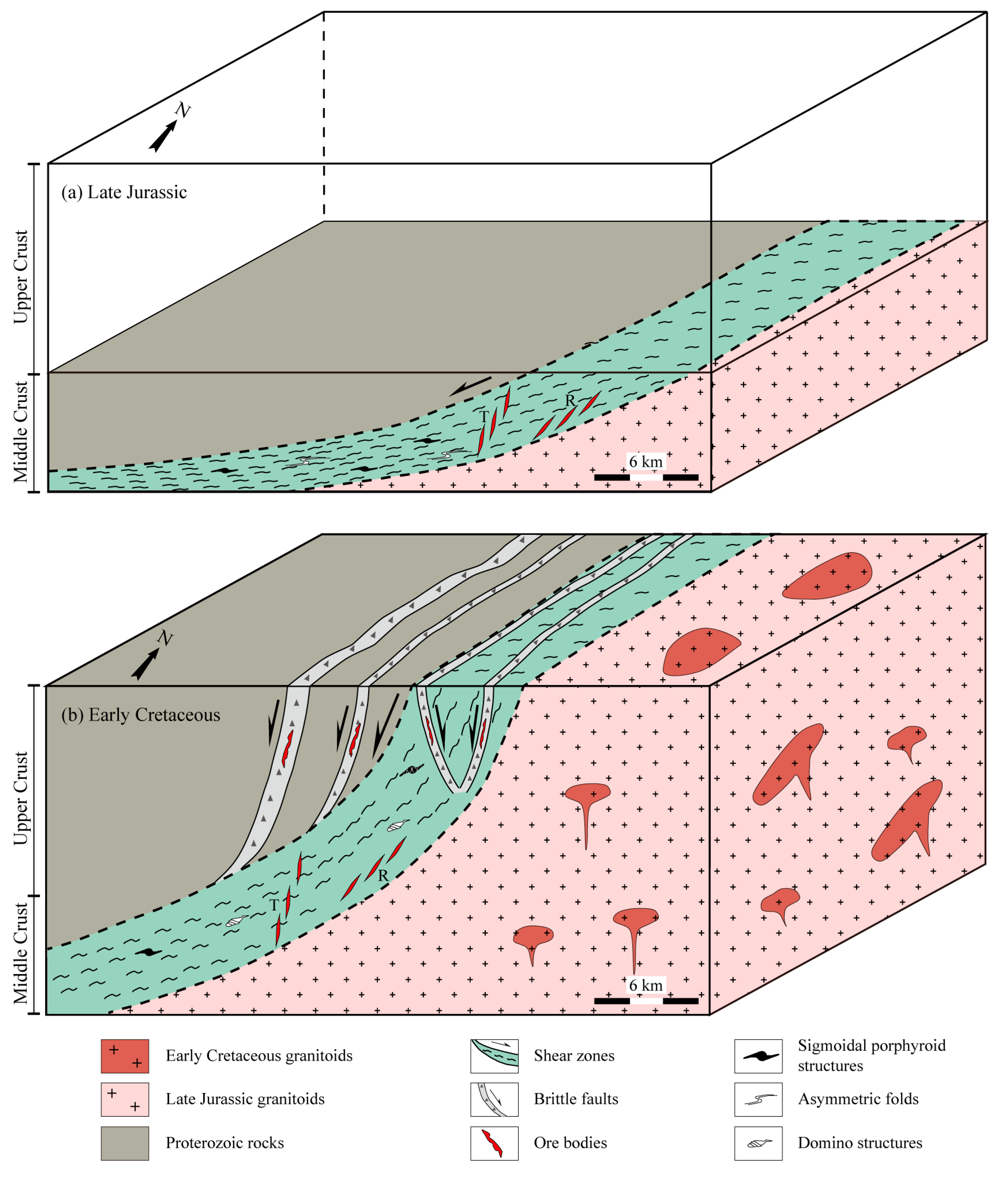


| DS | SN | Q | DD (μm) | AD (μm) | PD (μm) | AP (μm) | D | R2 |
|---|---|---|---|---|---|---|---|---|
| Microscopic Analysis | 3021 | 70 | 81.67–656.08 | 322.40 | 301.66–3286.99 | 1560.35 | 1.18 | 0.93 |
| 1030 | 68 | 89.60–658.94 | 261.61 | 337.22–3579.35 | 1195.34 | 1.16 | 0.93 | |
| 2917 | 61 | 55.67–985.64 | 282.04 | 158.22–5617.83 | 1296.59 | 1.21 | 0.98 | |
| 2810 | 51 | 84.17–1035.33 | 326.61 | 299.27–6825.53 | 1751.29 | 1.22 | 0.96 | |
| EBSD Analysis | 3021 | 84 | 106.16–687.44 | 279.33 | 379.32–3451.80 | 1319.81 | 1.17 | 0.92 |
| 1030 | 63 | 126.15–711.97 | 320.56 | 588.41–3799.84 | 1602.98 | 1.15 | 0.92 | |
| 2917 | 64 | 79.12–603.82 | 230.17 | 303.59–3539.50 | 1146.47 | 1.19 | 0.95 | |
| 2810 | 69 | 7.15–287.62 | 35.46 | 1600.04–75,606.36 | 9407.82 | 1.21 | 0.97 |
© 2019 by the authors. Licensee MDPI, Basel, Switzerland. This article is an open access article distributed under the terms and conditions of the Creative Commons Attribution (CC BY) license (http://creativecommons.org/licenses/by/4.0/).
Share and Cite
Cheng, N.; Hou, Q.; Shi, M.; He, M.; Liu, Q.; Yan, F.; Liu, H. New Insight into the Genetic Mechanism of Shear Zone Type Gold Deposits from Muping-Rushan Metallogenic Belt (Jiaodong Peninsula of Eastern China). Minerals 2019, 9, 775. https://doi.org/10.3390/min9120775
Cheng N, Hou Q, Shi M, He M, Liu Q, Yan F, Liu H. New Insight into the Genetic Mechanism of Shear Zone Type Gold Deposits from Muping-Rushan Metallogenic Belt (Jiaodong Peninsula of Eastern China). Minerals. 2019; 9(12):775. https://doi.org/10.3390/min9120775
Chicago/Turabian StyleCheng, Nannan, Quanlin Hou, Mengyan Shi, Miao He, Qing Liu, Fangchao Yan, and Hongwei Liu. 2019. "New Insight into the Genetic Mechanism of Shear Zone Type Gold Deposits from Muping-Rushan Metallogenic Belt (Jiaodong Peninsula of Eastern China)" Minerals 9, no. 12: 775. https://doi.org/10.3390/min9120775
APA StyleCheng, N., Hou, Q., Shi, M., He, M., Liu, Q., Yan, F., & Liu, H. (2019). New Insight into the Genetic Mechanism of Shear Zone Type Gold Deposits from Muping-Rushan Metallogenic Belt (Jiaodong Peninsula of Eastern China). Minerals, 9(12), 775. https://doi.org/10.3390/min9120775




